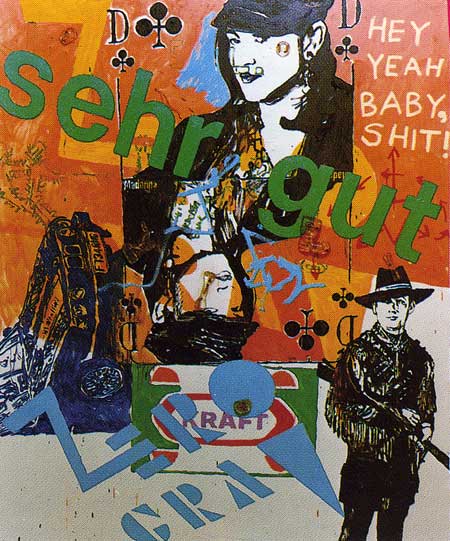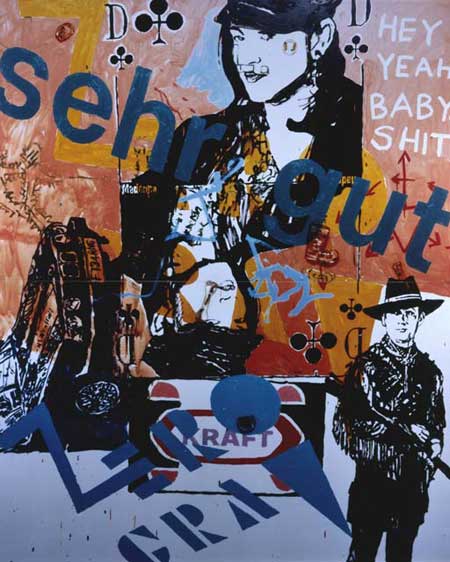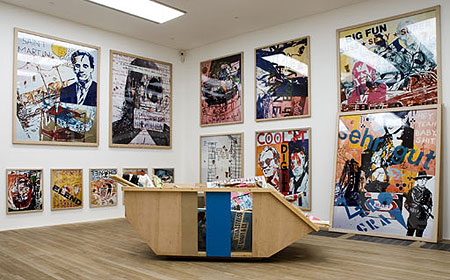


Kippenberger, Taschen catalog, 1991, where the top image was scanned from:
Untitled, 1989/90...On page 140-141...18 out of a total of 51 color photographs of paintings which one of Kippenberger's assistants painted after reproductions in catalogs. The paintings are destroyed and put into three containers designed by Kippenberger. The original works consist finally of two prints and three containers.
Tate Modern website (where the bottom two photos came from--note unfortunate cropping of middle image):
Heavy Burschi [Heavy Guy], 1991, brings together many of the defining themes of Kippenberger’s practice, both in terms of media and its process of production. Kippenberger asked an assistant to make paintings based on images from all his catalogues, but he was unsatisfied with the finished canvases. He ordered all fifty-one paintings to be destroyed, but first had each photographed, reprinted to its original size and framed, exhibiting them together, with the remnants of the paintings in a skip, as a single installation.
Kippenberger plays with the idea that an artist is an isolated individual who makes autonomous objects. He frequently used assistants, but his decision to destroy these paintings throws the question of authorship into sharp relief. Even though the canvases were only produced on his instructions, they were still the result of someone else’s labour, making their destruction a vivid demonstration of the relations between employer and employee.
Kippenberger’s actions echo the heroic gestures of destruction and renewal that run throughout Modernism, particularly in the work of post-war German artists such as Joseph Beuys and Anselm Kiefer. With his familiar barbed irony, however, Kippenberger’s gesture is anything but an affirmation of the redemptive power of the artist. Heavy Burschi exposes the violence inherent in acts of destruction, emptying the gesture of its heroic connotations of cultural, political and spiritual rebirth. Instead of destroying the present to create a new future, Kippenberger creates a feedback loop. He destroys the paintings only to show copies of them, which then become yet another series of unique works, transforming the pictures, in his own description, 'into a kind of double kitsch.'
Note how the Tate curators dramatize and embellish the tale of the destroyed paintings compared to the matter-of-fact description in the Taschen catalog. Writers just love their little stories. Imagine encountering this work without a curator salivating to tell you what it means. There are paintings in frames. Whoops, closer inspection shows they're not paintings, but photos of paintings. Did Kippenberger paint them? It looks like his style, but they're a bit "off" from his usual lunacy--almost like an illustrator imitating Kippenberger. Well, what's this in the bin? Woah, ripped up paintings. Are these the same--? Looks like they are. Hmmm, now these photos are tantalizing me with something I know no longer exists. I study them more closely. Do they depict "good" (ie complex, tasty) paint surfaces? Impossible to tell, but they look OK. The idea of a tasty painting exists in my mind. Isn't that as good as an actual tasty painting? These kinds of questions and considerations are surely much more interesting than Kippenberger's relationship to "heroic gestures of destruction and renewal." Or the possibly invented story of the master tearing up the apprentice's canvases, which the Tate gives us as some kind of class struggle allegory. Curators: you can't live with them, you can't kill them.
Just ponder that sentence: "Heavy Burschi exposes the violence inherent in acts of destruction, emptying the gesture of its heroic connotations of cultural, political and spiritual rebirth."
